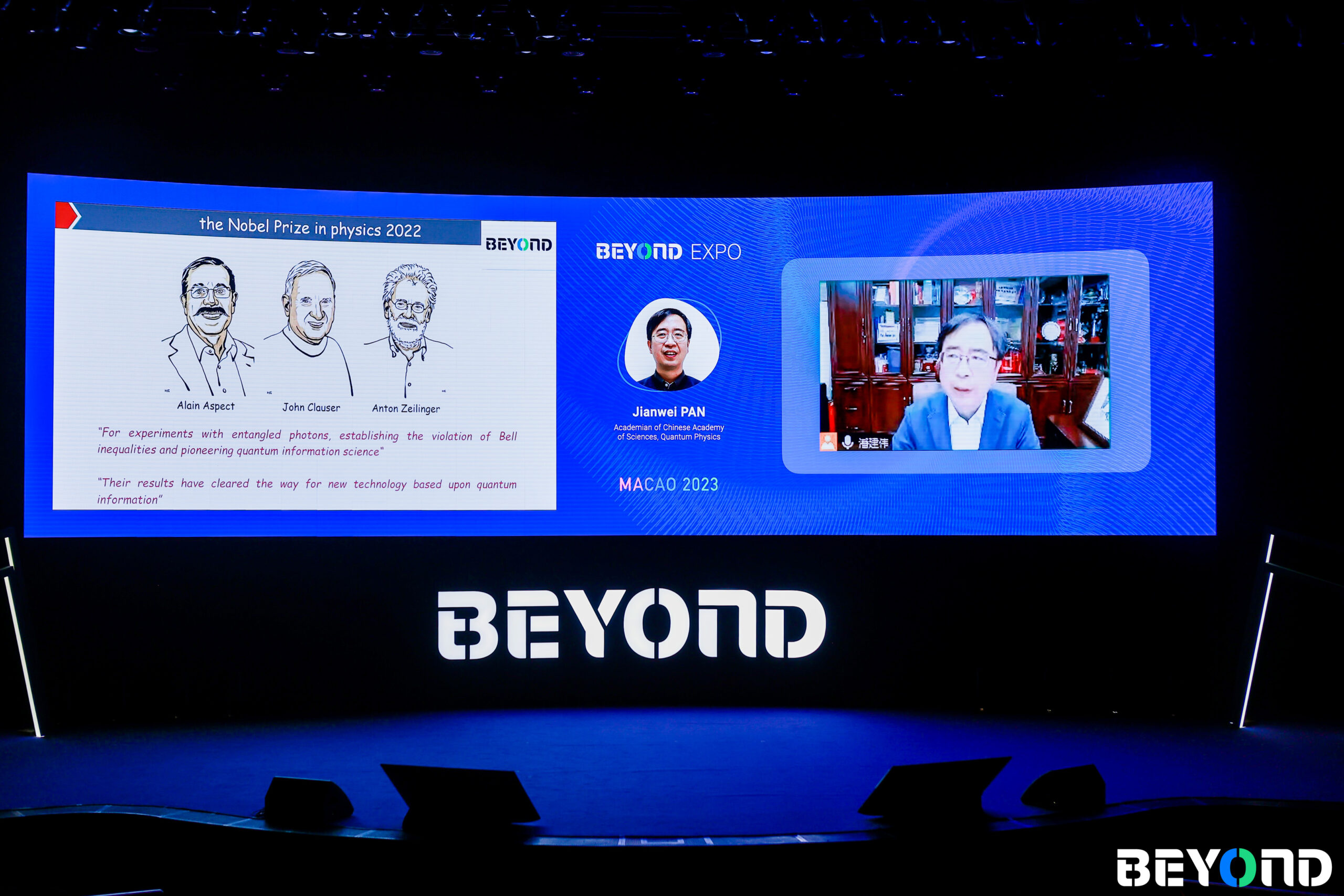
On Wednesday, Chinese quantum physics expert Jian-Wei Pan explained China’s progress in utilizing quantum physics at the BEYOND Expo 2023 in Macao, adding that the country still needs a long time to popularize quantum computing. He highlighted China’s efforts in developing the world’s first quantum science satellite, Micius, in 2016 and the long-distance fiber-optic quantum communication backbone network, the Beijing-Shanghai National Quantum Communication Backbone, in 2017.
Pan has conducted extensive research experience in quantum optics, quantum information and fundamental issues in quantum mechanics. He is particularly known for his systematic innovations in quantum communication, multiphoton entanglement manipulation and cold-atom quantum storage.
Please find below the transcript of the opening day speech from Jian-Wei Pan, Academian of Chinese Academy of Sciences, Quantum Physics. The following transcript has been edited for clarity:
The 2022 Nobel Prize in Physics has been awarded to scientists Alain Aspect, John F. Clauser, and Anton Zeilinger for their ‘experimental violations of the Bell inequalities using entangled photons, and for laying the foundations of quantum information science.’
The work of Chinese scientists was highlighted during the news conference and scientific presentation in the 2022 Nobel Prize in Physics, including the use of the Micius satellite for intercontinental quantum key distribution and Earth-quantum-channel distribution, as well as recent work on quantum key distribution.
Quantum information science mainly involves two applications: using quantum communication to provide a theoretically unconditional secure communication method, and using quantum computing to greatly improve computational power.
In quantum computing, information is encoded using quantum bits (qubits), and the superposition principle can be used to achieve ultra-fast parallel computation, resulting in exponential acceleration. Therefore, quantum computers can be used to solve a variety of problems in fields such as classical cryptography, weather forecasting, financial analysis and drug design.
To achieve a generalized quantum communication network, we can use fiber optics to build a metropolitan quantum communication system and use quantum relays to achieve intercity quantum communication. Further, with the help of quantum satellites, long-distance quantum communication can be realized. After nearly 20 years, Chinese scientists successfully developed the world’s first quantum science satellite, Micius, which was launched in August 2016. In addition, in September 2017, China’s long-distance fiber-optic quantum communication backbone network, the Beijing-Shanghai National Quantum Communication Backbone, was officially opened. Micius and the Beijing-Shanghai Backbone helped China preliminarily test the hypothesis of building a wide-area quantum communication network and prove in principle that a unified quantum network is feasible.
In the field of quantum computing, achieving a universal quantum computer will require significant effort over an extended period of time. To ensure the healthy development of this field, academia has set three stages of development for quantum computing. The first stage is the demonstration of the superiority of quantum computing, which means that the quantum computing system’s solving speed for certain specific problems has far surpassed that of classical supercomputers, demonstrating its inherent superiority. The second stage is the construction of a specialized quantum simulation machine used to solve specific complex problems that classical computers cannot handle, such as high-temperature superconducting mechanisms. And in the third stage, the goal is to achieve universal programmable quantum computing with the help of quantum error correction.
To achieve global quantum communication in the future, we need to overcome the challenges currently faced by satellite quantum centers. The first challenge is that a single low-orbit satellite cannot directly cover the entire globe. The second challenge is that current satellites can only operate in low-visibility areas. There are corresponding solutions to these challenges. One solution is to launch multiple low-orbit satellites to form an efficient satellite network, known as a “constellation.” On this basis, satellites with longer transit times in medium to high orbits can be launched to distribute more keys. However, the fundamental premise for these solutions is that satellites can work under the background of solar radiation.
And in July 2022, China launched the world’s first micro-nano quantum satellite, “Jinan-1.” With a payload of only 20 kilograms, it is much lighter than the Micius satellite. We are currently developing the first mid-to-high orbit quantum satellite, which is planned to be launched around 2026. In addition to achieving quantum key distribution, it also provides a new platform for quantum precision measurement. This quantum satellite can achieve quantum entanglement distribution on a scale of tens of thousands of kilometers. In the future, by utilizing global entanglement distribution, multiple atoms can be entangled to significantly improve stability in atoms. Using optical neutralization and ultra-precise transmission of light screen targets, we can construct a long baseline interferometer in outer space and carry out tests on fundamental physics principles, including the detection of dark matter and gravitational waves.
In the field of quantum computing, our goal is to achieve manipulation of hundreds of quantum bits in the future, allowing for the construction of dedicated quantum simulators that can help us understand complex physical systems, such as high-temperature superconductivity and quantum Bohr effects. Currently, through 10 to 15 years of effort, we hope to manipulate millions of quantum bits and achieve quantum error correction, ultimately building a programmable universal quantum computer.